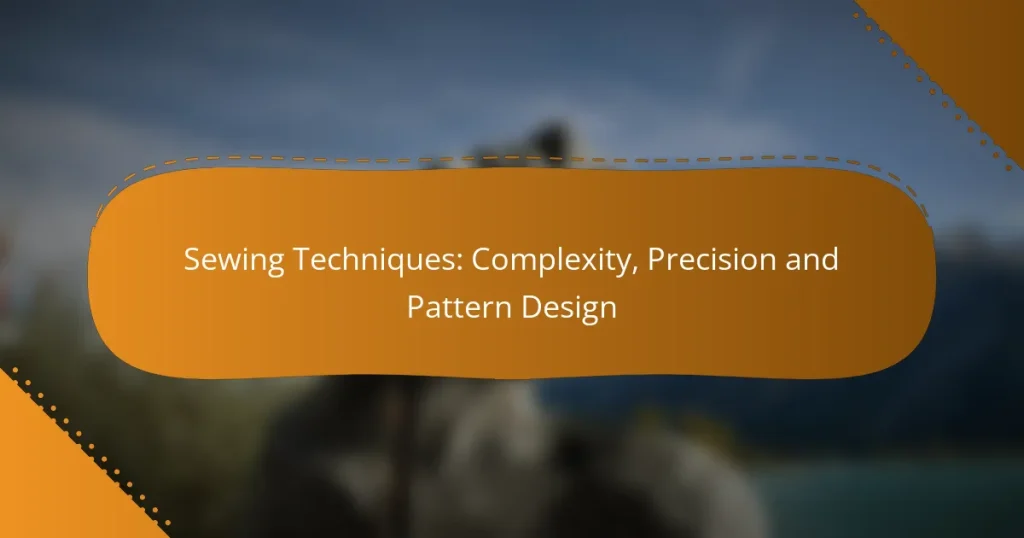Sewing techniques play a vital role in achieving both precision and complexity in your projects. By focusing on methods that enhance accuracy and durability, such as straight stitching and French seams, you can elevate the quality of your work. Additionally, the choice of sewing patterns influences the level of detail and skill required, allowing for a range of creative possibilities from simple to intricate designs.
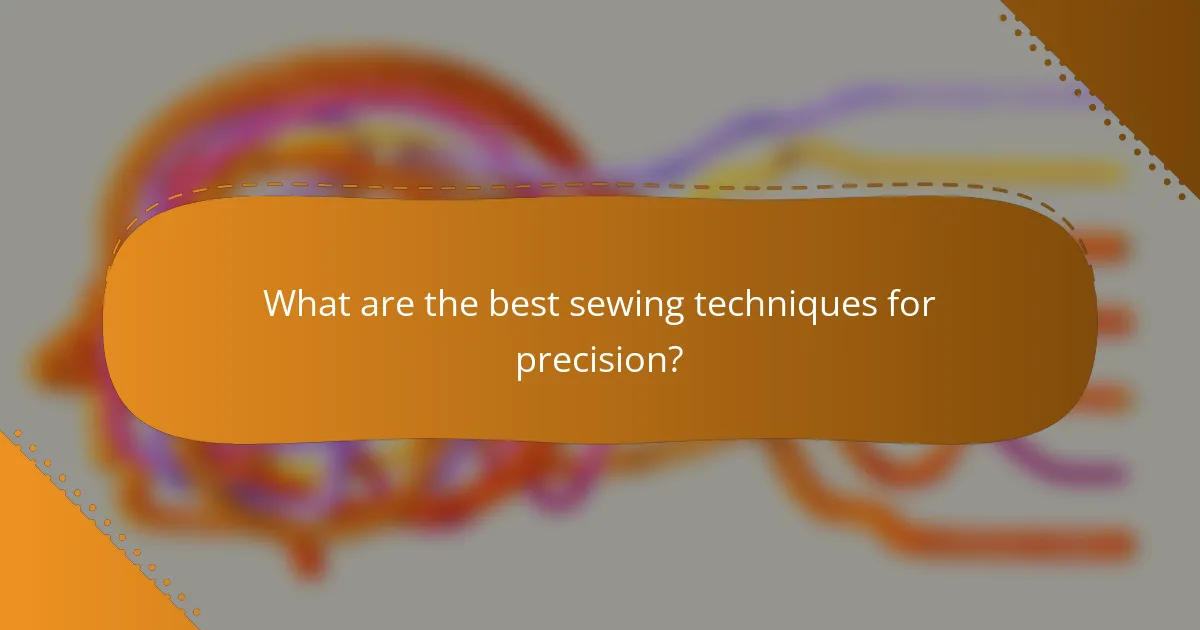
What are the best sewing techniques for precision?
The best sewing techniques for precision focus on accuracy and durability, ensuring clean finishes and strong seams. Employing methods like straight stitching, French seams, and bias binding can significantly enhance the quality of your sewing projects.
Straight stitch for accuracy
The straight stitch is fundamental for achieving precise seams in sewing. This technique involves sewing in a straight line, which is essential for aligning fabric pieces accurately. Use a standard straight stitch foot and adjust the stitch length to around 2.5 to 3 mm for most fabrics.
To ensure accuracy, always use a fabric guide or the edge of your presser foot as a reference. This helps maintain a consistent seam allowance, which is crucial for fitting and finishing. Avoid pulling the fabric while sewing to prevent distortion.
French seam for durability
The French seam is an excellent choice for creating durable and neat finishes, particularly on lightweight or sheer fabrics. This technique encloses raw edges, preventing fraying and enhancing the garment’s longevity. Start by sewing the fabric pieces with wrong sides together using a narrow seam.
After trimming the seam allowance, press the seam to the side and sew again with right sides together, encasing the raw edges. This method is ideal for delicate fabrics and adds a professional touch to garments. Remember to choose a compatible thread that matches the fabric for a seamless look.
Bias binding for clean edges
Bias binding is used to finish raw edges with a clean and polished look. This technique involves cutting fabric on the bias and folding it to create a binding that can be sewn around edges. It’s particularly useful for necklines, armholes, and hems.
To apply bias binding, first, measure the edge you want to finish and cut the binding strips accordingly, usually around 2.5 to 3 cm wide. Fold the binding in half lengthwise, press, and then align it with the edge of the fabric. Sew it in place, ensuring that the binding covers the raw edge completely. This method not only enhances aesthetics but also adds strength to the seams.
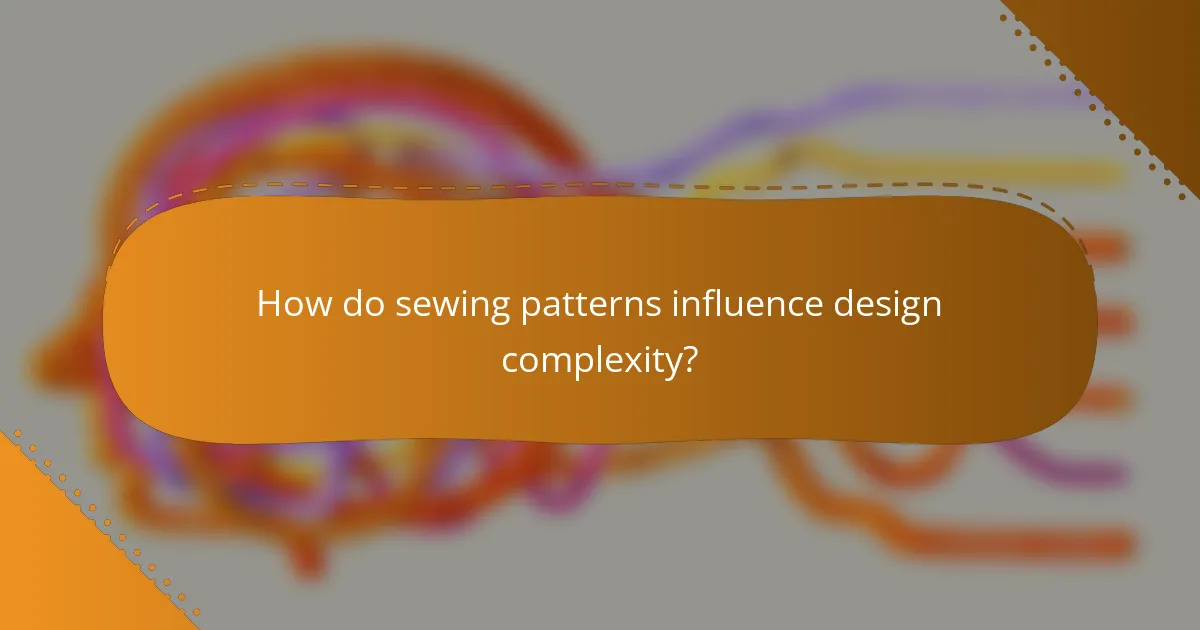
How do sewing patterns influence design complexity?
Sewing patterns significantly impact design complexity by dictating the level of detail and skill required for a project. Simple patterns often lead to straightforward designs, while intricate patterns can introduce advanced techniques and challenges.
Simple patterns for beginners
When selecting a simple pattern, look for designs labeled as “easy” or “beginner-friendly.” These often have clear instructions and minimal construction steps, making them accessible for those just starting out.
Complex patterns for advanced projects
Complex patterns cater to experienced sewers and often feature multiple pieces, intricate details, and advanced techniques like tailoring or draping. Examples include tailored jackets, formal dresses, or multi-layered garments. These projects require a solid understanding of sewing principles and techniques.
When tackling complex patterns, it’s crucial to take your time and follow instructions carefully. Consider breaking the project into manageable sections to avoid feeling overwhelmed. Additionally, investing in high-quality materials can significantly enhance the final result.

What tools enhance sewing precision?
To achieve precision in sewing, specific tools are essential. These tools help ensure accurate measurements, clean cuts, and clear markings, which are crucial for successful sewing projects.
Rotary cutter for clean cuts
A rotary cutter is a circular blade that rolls along the fabric, providing clean and precise cuts. It is especially useful for cutting multiple layers of fabric or intricate shapes, making it a favorite among quilters and garment makers.
When using a rotary cutter, consider investing in a self-healing cutting mat to protect your surfaces and prolong the blade’s sharpness. Always use a ruler or straight edge to guide your cuts, ensuring accuracy and preventing fabric slippage.
Tailor’s chalk for marking
Tailor’s chalk is a marking tool used to create temporary lines on fabric, helping you align seams and patterns accurately. Available in various forms, such as pencils, squares, and wheels, it allows for precise marking without damaging the fabric.
When using tailor’s chalk, choose a color that contrasts with your fabric for better visibility. Remember to test it on a scrap piece first to ensure it can be easily removed. Avoid pressing too hard, as this can leave permanent marks.

What are the prerequisites for mastering sewing techniques?
To master sewing techniques, one must develop a solid foundation in basic sewing machine operation and have a good understanding of different fabric types. These prerequisites are essential for achieving precision and creativity in pattern design.
Basic sewing machine knowledge
Familiarity with your sewing machine is crucial. This includes understanding its parts, functions, and how to troubleshoot common issues. Knowing how to thread the machine, adjust tension, and select the appropriate stitch type can significantly enhance your sewing experience.
Start by reading the machine’s manual and practicing basic stitches on scrap fabric. This will help you build confidence and improve your skills. Regular maintenance, such as cleaning and oiling, is also important to keep the machine in optimal condition.
Understanding fabric types
Different fabrics behave uniquely, which affects how they should be sewn. Familiarize yourself with common fabric types such as cotton, polyester, silk, and wool. Each fabric has its own characteristics, such as stretch, weight, and drape, which influence the choice of needle, thread, and stitch type.
For instance, lightweight fabrics like chiffon require a fine needle and a delicate stitch, while heavier fabrics like denim may need a thicker needle and stronger thread. Always test your sewing techniques on a sample piece to ensure the best results.
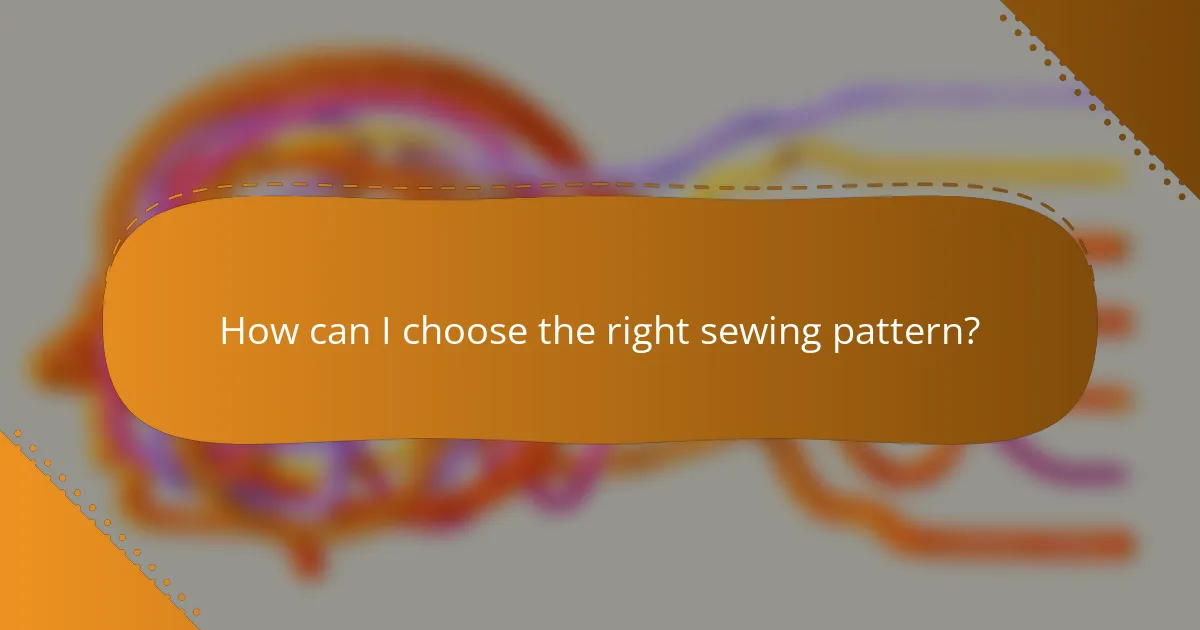
How can I choose the right sewing pattern?
Choosing the right sewing pattern involves assessing your skill level and the type of fabric you plan to use. A well-matched pattern will enhance your sewing experience and yield better results.
Consider skill level
Your skill level is crucial when selecting a sewing pattern. Beginners should opt for patterns labeled as “easy” or “beginner-friendly,” which typically feature fewer pieces and simpler construction techniques. Intermediate and advanced sewists can explore more complex designs that incorporate advanced techniques like tailoring or intricate embellishments.
To gauge your skill level, consider the types of projects you’ve completed successfully. If you have experience with basic garments, you might feel comfortable tackling patterns that include darts, zippers, or linings.
Evaluate fabric compatibility
Fabric compatibility is essential for achieving the desired look and fit of your finished project. Each pattern typically suggests specific fabric types, such as cotton, linen, or knits, which influence the drape and structure of the garment. Always check the pattern envelope for recommended fabrics and their characteristics.
When choosing fabric, consider its weight and stretch. For instance, lightweight fabrics work well for flowy dresses, while heavier fabrics are better suited for structured garments like jackets. If you’re unsure, start with a fabric that closely matches the pattern’s recommendations to ensure a successful outcome.
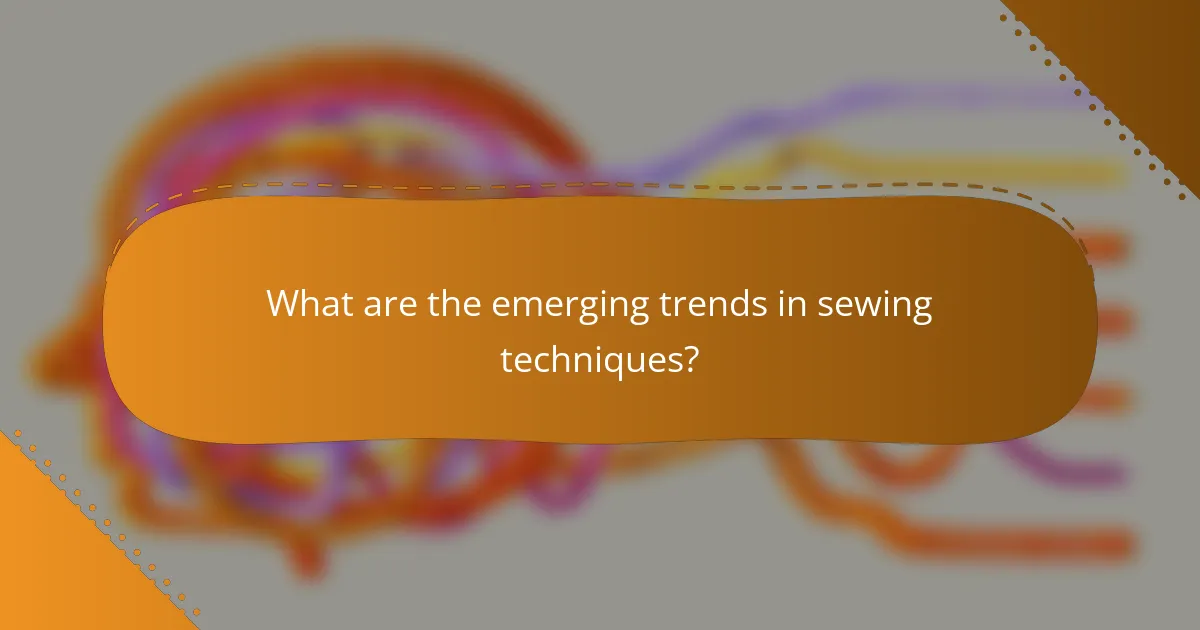
What are the emerging trends in sewing techniques?
Emerging trends in sewing techniques focus on sustainability, technology integration, and innovative materials. These trends reflect a growing awareness of environmental impact and the desire for precision and customization in sewing projects.
Sustainable fabric choices
Sustainable fabric choices are becoming increasingly popular among sewists who prioritize eco-friendliness. Fabrics made from organic cotton, hemp, and recycled materials reduce environmental impact and promote responsible consumption.
When selecting sustainable fabrics, consider certifications like GOTS (Global Organic Textile Standard) or OEKO-TEX, which ensure that materials meet specific environmental and social criteria. These fabrics may be slightly more expensive, typically ranging from 15% to 30% higher than conventional options, but they contribute to a more sustainable sewing practice.
Digital pattern design
Digital pattern design allows sewists to create and modify patterns using software, enhancing precision and customization. Programs like Adobe Illustrator or specialized sewing software enable users to draft patterns that fit their specific measurements and style preferences.
This trend not only saves time but also reduces fabric waste by allowing for precise cutting layouts. Many sewists are sharing their digital patterns online, often for free or at a low cost, making it easier to access unique designs without the need for traditional paper patterns.
3D printing in sewing
3D printing in sewing is an innovative technique that allows for the creation of intricate designs and components that would be difficult to achieve with traditional methods. This technology can produce buttons, embellishments, or even entire garments with complex structures.
While still emerging, 3D printing can significantly reduce material waste and allow for rapid prototyping. However, it requires investment in equipment and materials, which can vary widely in cost, often starting from a few hundred to several thousand dollars depending on the printer’s capabilities.
